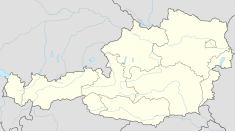Salzburg Cathedral
| Salzburg Cathedral | |
|---|---|
| Native name German: Salzburger Dom | |
 Exterior of the Salzburg Cathedral | |
| Location | Salzburg |
| Architectural style(s) | baroque |
The Salzburg Cathedral (German: Salzburger Dom) is a 17th century baroque cathedral of the Roman Catholic Archdiocese of Salzburg in the city of Salzburg, dedicated to Saint Rupert of Salzburg.
It is the site of Mozart's baptism. And the composer Anton Diabelli sang in the Salzburg Cathedral boys' choir in the late 1700s.[1]
History





The first cathedral was built under Saint Vergilius of Salzburg, who might have used foundations by St. Rupert. The first Dom was recorded in 774. The so-called Virgil Dom was built from 767 to 774 and was 66 metres long and 33 metres wide.
Archbishop Arno (785 – 821) was the first to arrange renovations of the Dom, which was in place for less than 70 years. In 842, the building burned down after being struck by lightning. Three years later, the re-erection of the building started.
Under Archbishop Hartwig, a choir with a crypt was built towards West between 1000 and 1020. Under Archbishop Konrad I., the West-towers were built from 1106 to 1147.
This original church thus experienced at least three extensive building and rebuilding campaigns during the early Middle Ages, the final result of which was a somewhat ad hoc Romanesque basilica. In 1598, the basilica was severely damaged, and after several failed attempts at restoration and reconstruction, the building was finally ordered to be demolished by Prince-Archbishop Wolf Dietrich (Archbishop from 1587–1612). Wolf Dietrich was a patron and supporter of modern Italian baroque architecture, having seen it from its origins in Italy and particularly Rome. Indeed, it was Wolf Dietrich who was also responsible for the building of the nearby Alten Residenz, which is today connected to the cathedral.
Wolf Dietrich hired the Italian architect Vincenzo Scamozzi to prepare a plan for a comprehensive new Baroque building. Construction did not begin however until Wolf Dietrich's successor, Markus Sitticus von Hohenems (Archbishop from 1612–19), in 1614 laid the cornerstone of the new cathedral. The present cathedral, designed by Santino Solari, who fundamentally changed the original Scamozzi plan was completed remarkably in less than 15 years, being finished by 1628. At its consecration on September 24, 1628, 12 choirs positioned in the marble galleries of the cathedral sang a Te Deum (the score of which is since lost) composed by Stefano Bernardi, the Kapellmeister to the Salzburg court. The present Salzburg Cathedral is built partially upon the foundations of the old basilica. Indeed, the foundation stones of the preceding church building may be seen in the Domgrabungen, an excavation site under the cathedral that also features mosaics and other artifacts found here when this location was the forum of the Roman city Juvavum. One other surviving relic that predates the baroque edifice is the 14th Century Gothic baptismal font. The relics of Saint Rupert were transferred here when the cathedral was completed.[2]
The finished church is 466 feet long and 109 feet high at the crossing/dome.[3] The baroque style of St. Rupert's can be seen in the choir and the nave.
The Salzburg Cathedral was damaged during World War II when a single bomb crashed through the central dome over the crossing. Repairs were somewhat slow to take place, but restoration was complete by 1959.
References
- ^ AllMusic.com
- ^ Butler's Lives of the Saints, ed. Paul Burns, Collegeville, MN 2003, p. 139.
- ^ Baedeker's Handbook for Travellers in Southern Germany (1914) p.182
External links
- Cathedral Museum Website
- Salzburg Tourist Office – salzburg city tourist board website.

